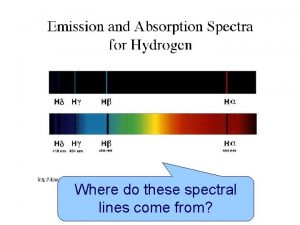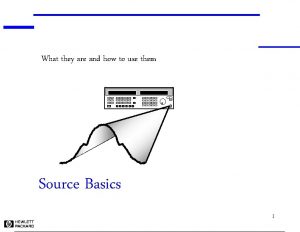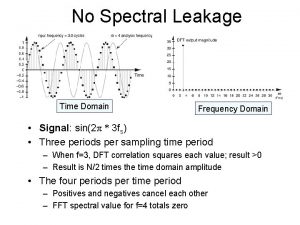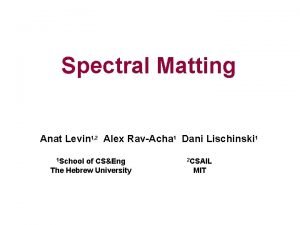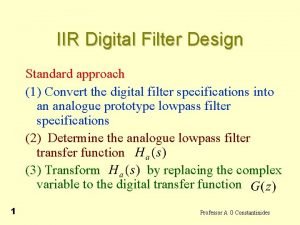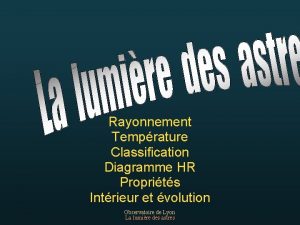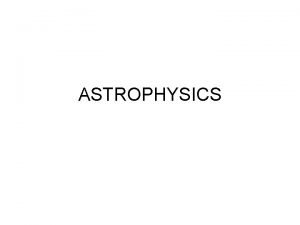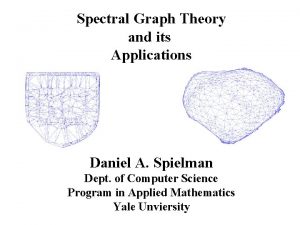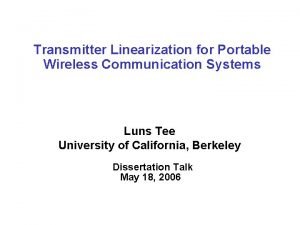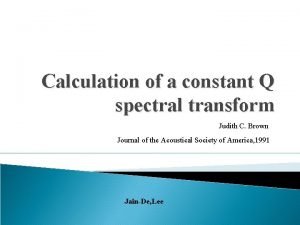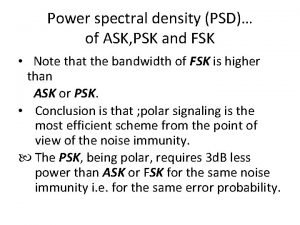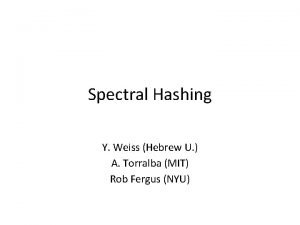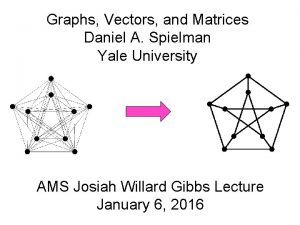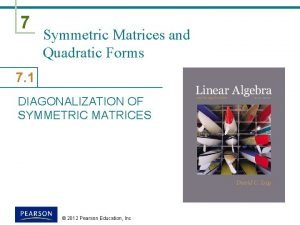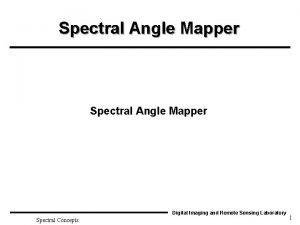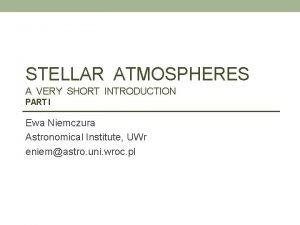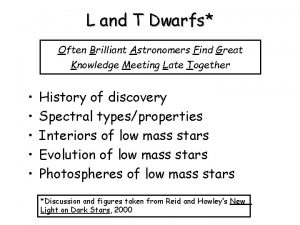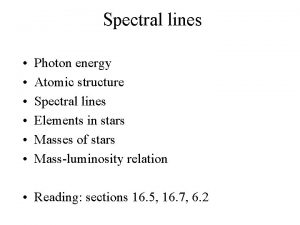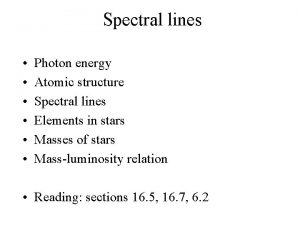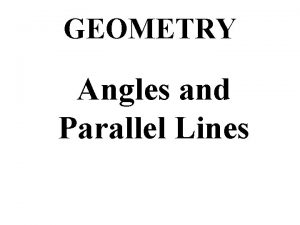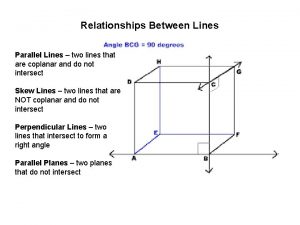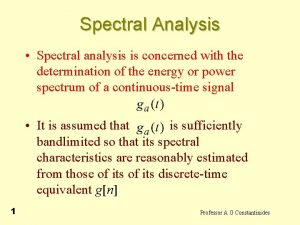Where do these spectral lines come from AS




































- Slides: 36

Where do these spectral lines come from? AS PHYSICS

R. Mulenga AS PHYSICS 2007

A sample of H atoms receives energy from an external source. Excited state H atom = e has absorbed energy (photon of light Ie the electron has ‘shifted up’ to a high energy shell / level A photon is released as the electron ‘shifts down’ to a lower – more stable energy shell / level

An excited H atoms electron returns to a lower energy level.

The colour of the photon emitted depends on the energy change that produces it.

Each photon emitted corresponds to a particular energy change.

Bohr proposed that the possible energy states for atomic electrons were quantized – only certain values were possible. Then the spectrum could be explained as transitions from one level to another.

Continuous or discrete energy levels? The difference between continuous and quantized energy levels.


Quantum staircase

See Ph. ET applet R. Mulenga AS PHYSICS 2007

Summary Quantized Energy Levels (n) • Electrons in free atoms are ‘Quantized’ ~ they reside only in discrete energy levels. Discrete energy levels are also termed ‘orbits, ’ states’ or ‘shells level’. §Only photon of exact energies are absorbed or emitted when electrons jump between higher and lower levels. §All energy values are defined as negative; this represents the energy which binds the electron to the nucleus and needs to be supplied for the electron to move up a level. §The lowest energy level (n=1) is called the ground state. • As n ∞, E 0. For Hydrogen, 13. 6 e. V is its Ionisation energy ~ the energy required to ionise the atom or strip its electron away. • Three basic ways to excite an electron in an atom (get to move to higher energy level): 1. Collide it with another atom or electron. 2. Heat it up (thermal excitation) 3. Bombard it with a photon of just the right energy (colour).

Find the ΔE between energy levels that gives the visible emission spectrum for Hydrogen ie red photons of 656 nm R. Mulenga AS PHYSICS 2007

Balmer Bohr

Balmer Bohr Why negative?

Hydrogen Atom - absorption n= E r 4 r 3 r 2 r 1 Ground state E 1 = 10. 2 e. V E 2 = 12. 1 e. V E 3 = 12. 75 e. V 0 e. V n=5 n=4 -0. 54 e. V -0. 85 e. V n=3 -1. 5 e. V n=2 -3. 4 e. V n=1 -13. 6 e. V

Hydrogen Atom – visible emission n= E r 4 r 3 r 2 r 1 656 0 e. V n=5 n=4 -0. 54 e. V -0. 85 e. V n=3 -1. 5 e. V n=2 -3. 4 e. V Ground n=1 state 486 434 410 -13. 6 e. V

Balmer Bohr

Rutherford’s Model § Gold foil / leaf experiment § Discovered dense positive piece of mass at the center of the atom called the nucleus § Nucleus contains positive protons § Mostly empty space • Negatively charged electrons orbiting the nucleus ~ Planet model

De Broglie Waves In 1924, the French physicist Louis de Broglie proposed that moving objects behave like waves; these are called matter waves. The de Broglie wavelength of a particle of mass m and speed v is l = h/mv.

• An 18 -wheeler moving at 100 km/h has a wavelength smaller than an atom. • However, an electron (very light) moves much faster and its wavelength is much larger than its size.

The Rutherford Model of the atom created its own set of problems: • Why didn’t the electron radiate away its own energy and fall into the nucleus? • Why did atoms emit only discrete wavelengths of light? The Bohr & de Broglie Models answered these questions. • Bohr built upon spectroscopic observations of atoms (Balmer) and that electrons have angular momentum properties. • de Broglie recognised that electrons are in a sense waves as well as particles (wave – particle duality). • They form standing waves around a certain orbit, like harmonics on resonating strings! • Only a whole number (n) of wavelengths will fit on a circumference. n is the quantized energy level number.



Video: Is the Electron a Wave or a Particle




Quantum Theory (dealing with small particles) • Builds on Bohr idea, atom is described using mathematical equations and the position of an electron is described in terms of its probability of being in a particular position. Schrodinger Derived a set of equations or wave functions for electrons. According to Schrodinger, electrons confined in their orbits would set up standing waves and you could describe only the probability of where an electron could be. The distributions of these probabilities formed regions of space about the nucleus were called orbitals. Orbitals could be described as electron density clouds Modern Model of the Atom ~ The electron cloud Spherical cloud of varying density which shows where an electron is more or less likely to be Subatomic particles (smaller them an atom) have been suggested and discovered (not in Level 3 NCEA Physics. . . )


Quantum Evolution: A Brief Timeline. Bohrs Model (1913) evolved from: § Planck’s Quantum Hypothesis (1900), Einstein’s Photoelectric Effect (1905). § Later developments that improved understanding of Quantum Mechanics were: § De Broglie’s Hypothesis (1923). § Paulli’s Exclusion Principle (1925) § Schrodingers Wave Equation (1926). § Heisenberg’s Uncertainty Principle (1927).

Extra notes…

The Origin of Light The diagrams to the right show a Hydrogen atom that begins in the energy state of n=3 (n is used to count the energy levels. ) Notice that at n=3 there are 3 complete waves in that loop that is the electron. Creating more waves in the same length of a spring requires more energy. If more energy was added, it may or may not move the electron to the higher energy level. If it is only enough energy to take it to n=3. 25, the wave will stay at the n=3 level. This is because the end of the wave and the beginning of the wave must be able to connect in phase. At n=3. 25, one end of the wave is on its way up, the other on its way down. Physically, they can't connect. For this reason we would say that n=3. 5 or 3. 8 or 2. 9 or 11. 6 is not "allowed". In fact, only whole numbers of waves are allowed. We say they are quantized to only certain amounts. If just the right amount of energy has been put in, then the electron will jump to being a wave with 4 complete waves. Then a photon (wave packet) of light comes in from the left. The energy of the photon just happens to be exactly the amount needed to raise the electron up to the next energy level of n=4. Notice at n=4 there are 4 complete waves. We would say that an electron at n=4 is more excited or energetic than an electron at n=3. Due to the desire to keep lower energy levels full, the electron eventually drops back down to n=3 and ejects a photon of light. This photon is exactly the same energy (same color) as the photon it absorbed. This leads to the idea that an atom can only produce the colors of light (emission spectrum) that match the colors they can absorb (absorption spectrum).



Balmer Empirical equation
 Come rico
Come rico Rotational spectral lines
Rotational spectral lines Neon spectral lines
Neon spectral lines Non rigid rotator
Non rigid rotator Atomic spectral lines
Atomic spectral lines Application of rotational spectroscopy
Application of rotational spectroscopy Expected shortfall normal distribution
Expected shortfall normal distribution Spectral regrowth
Spectral regrowth Spectral clustering
Spectral clustering Yagami doc
Yagami doc Global spectral model
Global spectral model Spectral normalization for generative adversarial networks
Spectral normalization for generative adversarial networks Aim 6 letters
Aim 6 letters Adobe audition pitch shifter
Adobe audition pitch shifter Analytical spectral devices
Analytical spectral devices Spectral leakage
Spectral leakage Spectral matting
Spectral matting Spectral transformation of iir filters
Spectral transformation of iir filters Domaine spectral
Domaine spectral Spectral class
Spectral class Spectral graph theory and its applications
Spectral graph theory and its applications Spectral regrowth
Spectral regrowth Video spectral comparator
Video spectral comparator Calculation of a constant q spectral transform
Calculation of a constant q spectral transform Psd of ask
Psd of ask Spectral hashing
Spectral hashing Spectral graph theory spielman
Spectral graph theory spielman Symmetric matrix theorem
Symmetric matrix theorem Spectral bands
Spectral bands Spectral angle mapper
Spectral angle mapper Spectral imaging
Spectral imaging Spectral sensitivity
Spectral sensitivity Spectral graph
Spectral graph How to read chromosome
How to read chromosome Spectral classification
Spectral classification Spectral clustering
Spectral clustering Spectral classes
Spectral classes




